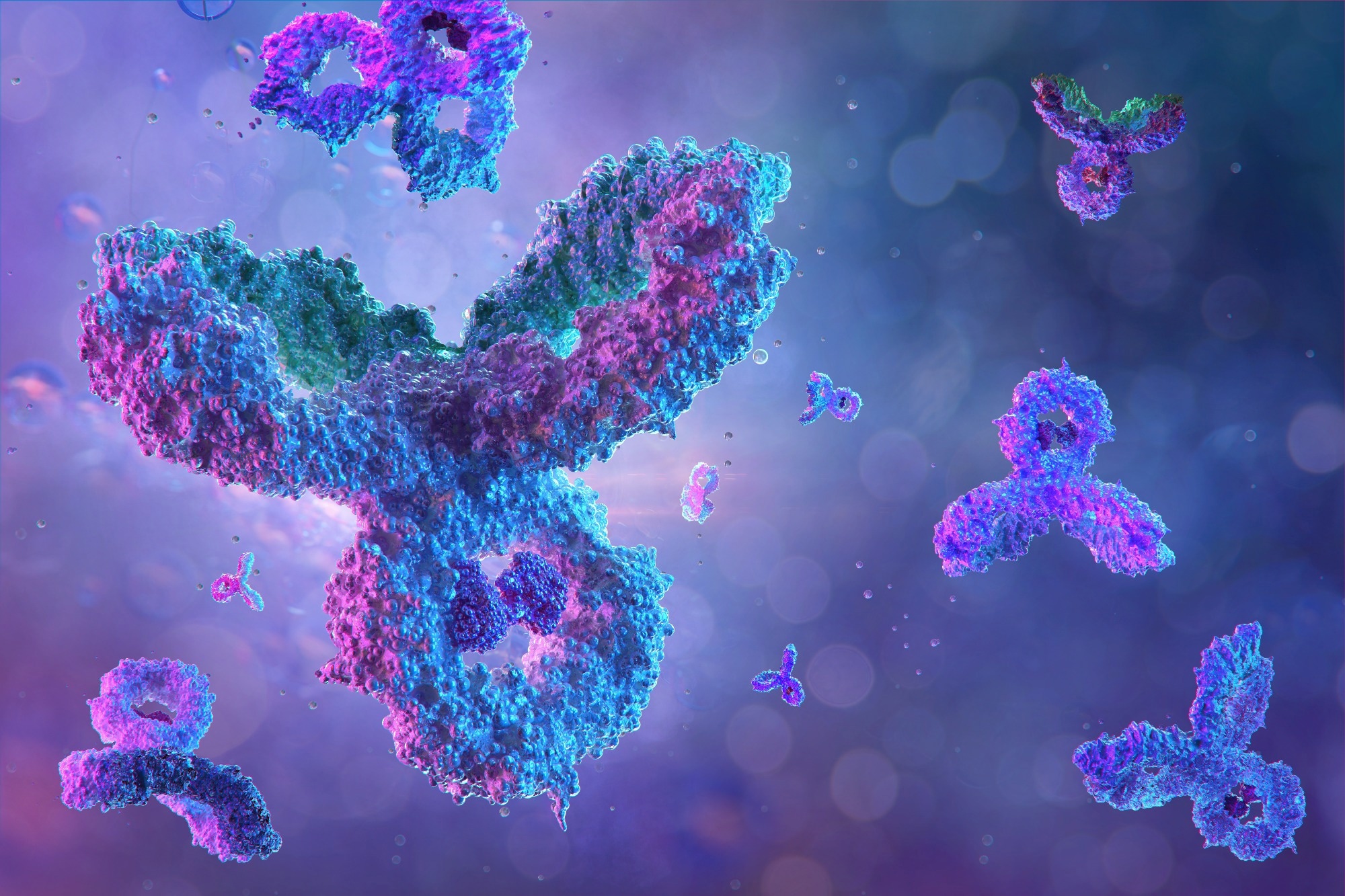In a recent study published in the Molecular Therapy journal, researchers explored strategies for developing effective monoclonal antibodies (mAbs) against severe acute respiratory syndrome coronavirus 2 (SARS-CoV-2).

Background
Several neutralizing antibodies (nAbs) that bind to the SARS-CoV-2 spike protein have been approved by the Food and Drug Administration (FDA) to treat coronavirus disease 2019 (COVID-19). This is primarily due to the essential role of receptor-mediated host cell identification and internalization of SARS-CoV-2 in viral propagation.
Mutations in the prototype spike receptor-binding domain (RBD) have rendered antibodies ineffective in neutralizing the virus and significantly reduced the efficacy of vaccines. Therefore, the emergence of SARS-CoV-2 variants of concern (VOCs) as a result of the virus' ongoing evolution is explicitly relevant to the effectiveness of COVID-19 therapeutics. Critical analyses are also needed to understand how the spike's positively chosen mutations modify the viral function and evade the immune response.
SARS-CoV2 VOCs and ACE2 binding
The increased angiotensin-converting enzyme-2 (ACE2) binding found in the SARS-CoV-2 Beta variant that resulted in the second wave of COVID-19 in 2020 was mostly driven by three mutations, K417N, E484K, and N501Y. The spike's K417N/T alterations differentiate the Beta and Gamma variants, which have comparable ACE2-binding affinities. The Delta variant, which in April 2021 caused the deadliest COVID-19 wave, had ten changes in its spike, including T19R and G142D, wherein the L452R and T478K mutations improved ACE2 binding. The SARS-CoV-2 Omicron variant first appeared with the greatest number of changes in its spike, which not only significantly improved its ACE2 binding, infectivity, and transmission but also facilitated the evasion of a majority of nAbs and vaccines.
All 195 amino acids found in the viral RBD are linked to mutations in the spike protein. However, not all mutations that have been proposed include ACE2 binding. A thorough mutational investigation conducted during the early phases of the COVID-19 pandemic discovered mutations in the RBD that modified ACE2 binding and/or were appropriate for antibody-based therapies. Surprisingly, only six of the 16 RBD mutations involved in immune evasion of the VOCs – namely, G339D, L452R, S477N, T478K, E484K, and N501Y- were associated with higher ACE2 binding. Furthermore, by selecting the best-fitting mutations within the antigenic (Ag) epitopes, the positive selection of the VOCs could be associated with the increase in resistance to the post-vaccinated and convalescent sera.
A molecular modeling investigation performed by the team showed that Omicron binds ACE2 almost 2.5 times more firmly than the original strain. This was accounted for by substitutions including T478K, Q493K, and Q498R, while K417N and E484A performed opposite roles. Because of this, the theory that mutations caused enhanced ACE2 binding proved ineffective in explaining the intricate nature of viral host adaptability. The increasing mutation rates in SARS-CoV-2 are likely the results of net-positive mutations that arise under atypical circumstances, such as host immunological response, potential zoonotic occurrences, and viral adaptation, rather than solely owing to selective pressure.
Mutations in the ACE2 competing RBD epitopes
The team modeled 3D structures of these mAbs with Beta and Gamma RBDs to examine the interface. It was discovered that E484K eliminated the electrostatic contact to complementarity-determining region H2 (CDRH2) and CDRL3 of bamlanivimab, while K417N dissolved contacts with CDRH2 of etesevimab. Imdevimab and casirivimab both bind two non-overlapping epitopes on RBD, hence the latter maintained its beta neutralization whereas casirivimab's neutralization capacity was significantly reduced as a result of the E484K change. Enhancing the Delta RBD-ACE2 interaction by the L452R and T478K mutation eliminated regdanvimab's ability to neutralize the Delta version.
The team also noted that regdanvimab and bamlanivimab escape was directly attributed to N417N and E484A, significantly lowering the ACE2-RBD binding affinity. This discovery further supported the hypothesis that higher mutation rates in SARS-CoV-2 are likely the result of net-positive mutations that emerge under atypical circumstances rather than enhanced ACE2 affinity. In light of Omicron's immune escape and the emergence of its subvariants, including BA.2, the FDA updated its approval for the use of two mAb-based cocktail medicines such as etesevimab/bamlanivimab cocktail and casirivimab/imdevimab cocktail in COVID-19.
Repositioning VOC-escaped mAbs using CDR diversification
While certain antibodies display better effectiveness against VOCs as well as other sarbecoviruses, others undergo numerous mutations that allow novel variants to evade the immune system. Since SARS-CoV-2 was characterized with its efficient immune evasion, CDR diversification was deemed a viable option for redesigning escaped antibodies that were previously developed against specific variants. This development is facilitated by information related to pre-defined hotspots-mediated epitope-paratope. In recent times, AstraZeneca has used these methods to increase the affinity of hybridoma-derived AB1 against murine chemokine ligand 20 (muCCL20).
Overall, the study showed the development of a method that partially emulated the biased pose-prioritization binding found in the docking algorithms as well as the heuristic design strategy. The stability and resistance of the resultant poses to conformational changes and reorientation may also be confirmed by in-solvent modeling of the Ab-Ag poses.
- The paradigm of immune escape by SARS-CoV-2 variants and strategies for repositioning subverted mAbs against escaped VOCs. Molecular Therapy (2022). doi: https://doi.org/10.1016/j.ymthe.2022.08.020 https://www.cell.com/molecular-therapy-family/molecular-therapy/fulltext/S1525-0016(22)00508-1
Posted in: Medical Science News | Medical Research News | Disease/Infection News
Tags: ACE2, Angiotensin, Antibodies, Antibody, binding affinity, Cell, Chemokine, Coronavirus, Coronavirus Disease COVID-19, covid-19, Efficacy, Enzyme, Evolution, Food, Immune Response, Immune System, Ligand, Mutation, Omicron, Pandemic, Propagation, Protein, Receptor, Respiratory, SARS, SARS-CoV-2, Severe Acute Respiratory, Severe Acute Respiratory Syndrome, Spike Protein, Syndrome, Therapeutics, Virus

Written by
Bhavana Kunkalikar
Bhavana Kunkalikar is a medical writer based in Goa, India. Her academic background is in Pharmaceutical sciences and she holds a Bachelor's degree in Pharmacy. Her educational background allowed her to foster an interest in anatomical and physiological sciences. Her college project work based on ‘The manifestations and causes of sickle cell anemia’ formed the stepping stone to a life-long fascination with human pathophysiology.
Source: Read Full Article
